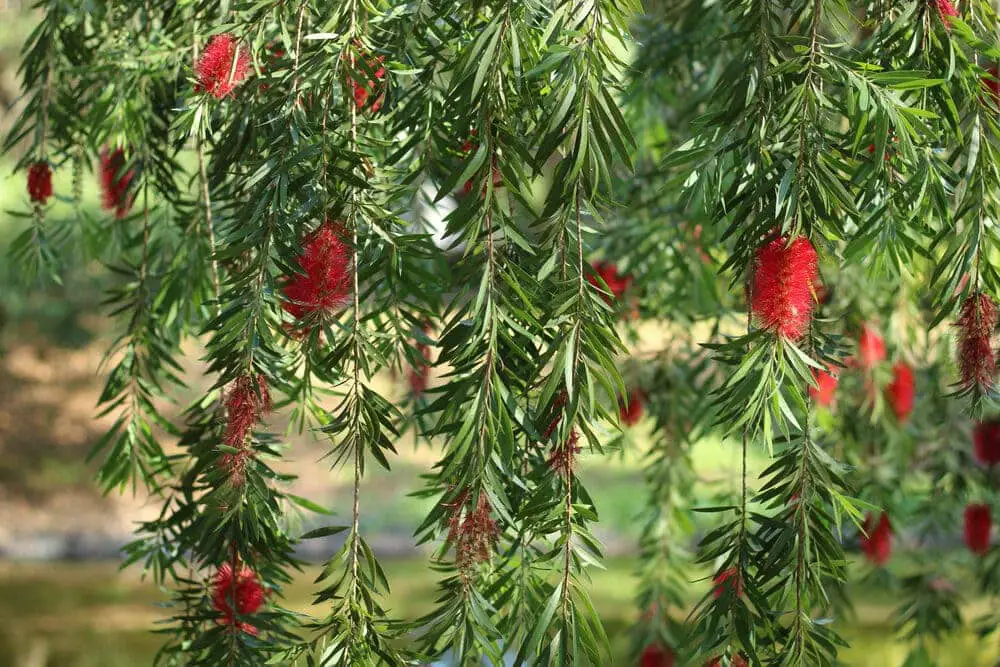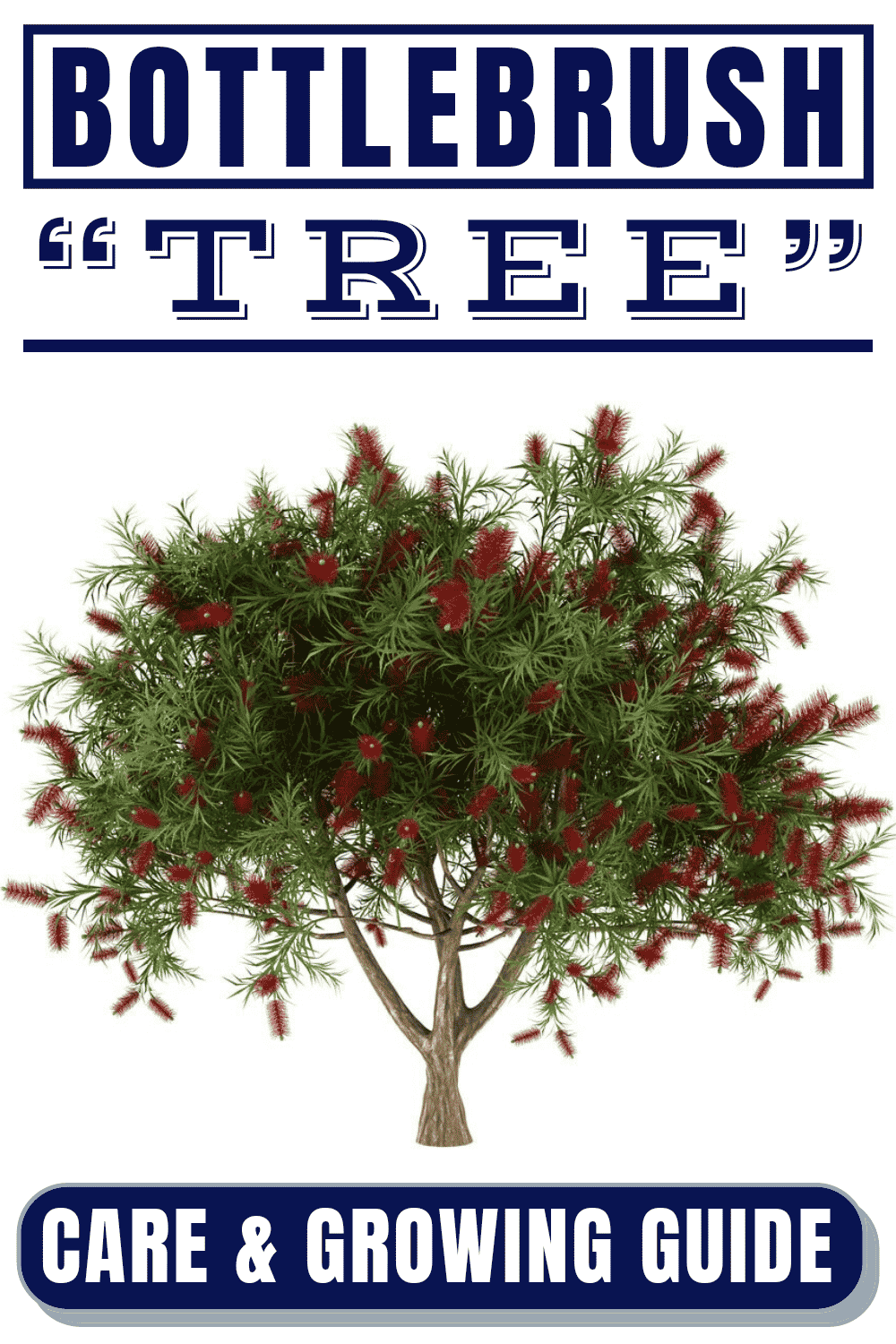The bottle brush tree is called so because its flowers are shaped like a brush that you use to wash bottles.
Despite its name, this tree is actually a shrub. This plant is great for your indoor garden, or you can keep it outside if the area you live in regularly experiences mild weather.
It’s bright red flowers attract a multitude of insects and wildlife, like hummingbirds and butterflies. There are over 50 types of bottle brush trees.
Bottlebrush Tree Care & Growing Guide
1. Light Requirement
The bottle brush tree needs to be exposed to full sun for at least 6 hours a day to keep up its vibrant red flowers. Do not place this tree in the shade or by plants that are larger than it. If this plant is in a container indoors, it still needs to be exposed to a lot of direct light. Keep it near a very sunny window.
2. Water
When this plant is young, it should be watered often. But when it reaches maturity it becomes more drought tolerant and it’s watering should become infrequent. Once a week is good in the spring and summer. Don’t water it if it has rained recently.
3. Climate and temperature
This plant doesn’t like extreme weather, so if you have hot or cold days, be sure to bring it inside if you can. It does best in hardiness zones 8 to 11. It can live in temperatures that range from 50F to 90F. If it is in warm weather, it can live in flower all year long.
4. Soil
This plant does well in any soil that is not too alkaline. It also does well in acidic soil. It will need to be fertilized in the spring and summer.
Spreading mulch around the soil underneath the bottle brush tree helps keep the soil moist and reduces watering even more. If this tree is in a container, it needs to be well-draining, or else it will quickly suffer root rot.

5. How to repot the Bottlebrush tree
Because this shrub grows so fast, it must be regularly repotted into bigger containers. In each repotting provide the bottlebrush with fresh soil. On average, it will be repoted every two to three years. If the roots of these plants are coming out of the drainage holes, then you know it’s time to change containers. Before you repot it, it must be trimmed back to encourage more growth. During repotting, shake out excess oil as much as you can around the roots. Slowly add fresh soil to its roots until they are entirely covered in the pot. When you are done, water the ground and make it damp.
6. Speed of Growth
The shrub is fast-growing, and they can grow up to 3 feet a year if the weather is right and there is fertilizer in the soil. Therefore, trimming the bottlebrush is so essential if you want to keep it at a certain height.
7. Height and Width of the plant
Even though this fast is a shrub and not a real tree, if the conditions are right, these plants can grow up to 15 feet tall. Constant trimming is needed to make sure it doesn’t grow farther than what you want. Its width can reach around 5 to 6 ft.
8. Trimming
Trimming this shrub is a necessity as it helps promote growth and flower bloom. Trim the tips of the stems and clear any dead matter. Watch out not to snip off the flower buds.
Is the Bottlebrush tree poisonous?
. You will be happy to know that this beautiful plant is not toxic to animals or humans. But it’s parts are still inedible so do not add them to your food.
Can the Bottlebrush tree grow in water?
No, this plant cannot grow in water. Too much water will quickly kill it.

Does this plant have flowers and how to get to Flower?
Yes, the bottle brush tree is known for its red flowers which are shaped like a bottle brush, hence the name. Its flowers are spikes and sit at the very edge of the stem. To ensure this flower blooms, make sure to expose the plant to a lot of light. If its soil is poor, then it will need to be fertilized. Also, watch out when you trim this plant as you can accidentally cut off the flowers when they’re not in bloom.
More like this: Hibiscus Tree Care & Growing Guide
Common Bottlebrush Tree Diseases
Root rot occurs when the ground around the bottle brush tree is soaked in water and cannot drain, causing waterlogged roots. The first signs of root rot will show the base of the plant starting to turn brown, and the leaves are beginning to wilt. To combat root rot, the soil must dry completely. Also, you must remove all dead and decaying parts of the plant.
Twig gall is another disease that occurs from overwatering. The main sign your plant has of twig gall will be strange looking growths on the stems and branches that look bloated and fat. This is a disease caused by small wasps or other small insects. The growths are a food resource for the insects, and they can use it for shelter. To get rid of galls is quite an endeavor. You must cut every gall off of your plant, and you have to use a small flame to burn any insect inside. Do not compost the galls once you remove them. Throw it away immediately.
Also read:
- Bougainvillea Plant Care & Growing Guide
- Calathea Plant Care & Growing Guide
- How Do You Propagate a Money Tree? [COMPLETE GUIDE]
Conclusion
- The bottle brush tree comes from Australia.
- It grows at a fast pace; around three feet a year
- Keep the grounds moist, but don’t soak it.
- It can grow up to 15 feet.
- Over 50 types of bottle brush trees exist.
- After you report it, make sure it stays moist.
- After this plant reaches maturity, you won’t have to water it so much.
- It is non-toxic, so you can have this plant around children and animals.
- It needs to be fertilized regularly, especially in the soil it’s in is poor.
- This plant is often confused with the bottle brush buckeye plant.
- If your plant gets twig gall, you must remove each gall by hand.

Victoria is the owner and main author of hobby plants. She loves spending her free time in her garden planting and taking care of her plants. Victoria hopes you enjoy the content here!
![How Do You Propagate a Money Tree? [COMPLETE GUIDE] How Do You Propagate a Money Tree? [COMPLETE GUIDE]](https://www.hobbyplants.com/wp-content/uploads/2022/06/how-to-propagate-money-tree-300x158.jpg)
![Best Soil For A Money Tree? [DIFFERENCES EXPLAINED] Best Soil For A Money Tree? [DIFFERENCES EXPLAINED]](https://www.hobbyplants.com/wp-content/uploads/2022/08/best-soil-for-money-tree-300x158.jpg)
![Mother Of Thousands Plant [Complete Plant Care Guide] Mother Of Thousands Plant [Complete Plant Care Guide]](https://www.hobbyplants.com/wp-content/uploads/2022/07/mother-of-thousands-plant-300x158.jpg)
![How Often Should You Water Pothos? [Complete Care Guide] How Often Should You Water Pothos? [Complete Care Guide]](https://www.hobbyplants.com/wp-content/uploads/2022/07/how-often-to-water-pothos-300x158.jpg)
![Can Snake Plants Live Outside? [COMPLETE CARE GUIDE] Can Snake Plants Live Outside? [COMPLETE CARE GUIDE]](https://www.hobbyplants.com/wp-content/uploads/2022/08/can-snake-plants-live-outside-300x158.jpg)
![Majesty Palm Plant Care: [Complete Beginner's Guide] Majesty Palm Plant Care: [Complete Beginner's Guide]](https://www.hobbyplants.com/wp-content/uploads/2022/08/majesty-palm-care-300x158.jpg)
![Exotic Angel Plant Care: [Complete Beginner's Guide] Exotic Angel Plant Care: [Complete Beginner's Guide]](https://www.hobbyplants.com/wp-content/uploads/2022/08/exotic-angel-plant-care-300x158.jpg)
![Do Coleus Like Sun Or Shade: [Complete Care Guide] Do Coleus Like Sun Or Shade: [Complete Care Guide]](https://www.hobbyplants.com/wp-content/uploads/2022/08/coleus-sun-or-shade-300x158.jpg)
![Snow White Waffle Plant: [Complete Care Guide] Snow White Waffle Plant: [Complete Care Guide]](https://www.hobbyplants.com/wp-content/uploads/2022/08/snow-white-waffle-plant-300x158.jpg)
![Waffle Plant Care: [Complete Beginner's Guide] Waffle Plant Care: [Complete Beginner's Guide]](https://www.hobbyplants.com/wp-content/uploads/2022/08/waffle-plant-300x158.jpg)
![Bird Of Paradise Plant Care: [Complete Beginner's Guide] Bird Of Paradise Plant Care: [Complete Beginner's Guide]](https://www.hobbyplants.com/wp-content/uploads/2022/08/bird-of-paradise-plant-300x158.jpg)
![Purple Passion Plant Care: [Complete Beginner's Guide] Purple Passion Plant Care: [Complete Beginner's Guide]](https://www.hobbyplants.com/wp-content/uploads/2022/08/purple-passion-plant-care-300x158.jpg)